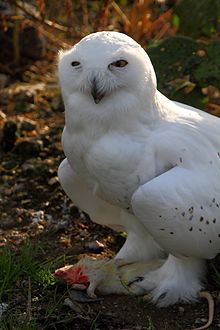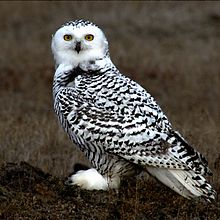- Snowy Owl
-
Snowy Owl 
Conservation status Scientific classification Kingdom: Animalia Phylum: Chordata Class: Aves Order: Strigiformes Family: Strigidae Genus: Bubo Species: B. scandiacus Binomial name Bubo scandiacus
(Linnaeus, 1758)
Summer WinterSynonyms Strix scandiaca Linnaeus, 1758
Nyictea Scandiaca Stephens, 1826The Snowy Owl (Bubo scandiacus) is a large owl of the typical owl family Strigidae. The Snowy Owl was first classified in 1758 by Carolus Linnaeus, the Swedish naturalist who developed binomial nomenclature to classify and organize plants and animals. The bird is also known in North America as the Arctic Owl, Great White Owl or Harfang. Until recently, it was regarded as the sole member of a distinct genus, as Nyctea scandiaca, but mtDNA cytochrome b sequence data (Olsen et al. 2002) shows that it is very closely related to the horned owls in the genus Bubo. The Snowy Owl is the official bird of Quebec.
Contents
Description
This yellow-eyed, black billed white bird is easily recognizable. It is 52–71 centimetres (20–28 in) long with a 125–150 centimetres (49–59 in) wingspan. Also, these birds can weigh anywhere from 1.6–3 kilograms (3.5–6.6 lb).[2] It is one of the largest species of owl and in North America is on average the heaviest owl species. The adult male is virtually pure white, but females and young birds have some dark scalloping; the young are heavily barred, and dark spotting may even predominate. Its thick plumage, heavily-feathered taloned feet, and coloration render the Snowy Owl well-adapted for life north of the Arctic Circle.
Snowy Owl calls are varied, but the alarm call is a barking, almost quacking krek-krek; the female also has a softer mewling pyee-pyee or prek-prek. The song is a deep repeated gawh. They may also clap their beak in response to threats or annoyances. While called clapping, it is believed this sound may actually be a clicking of the tongue, not the beak.
Ecology
The Snowy Owl is typically found in the northern circumpolar region, where it makes its summer home north of latitude 60 degrees north. However, it is a particularly nomadic bird, and because population fluctuations in its prey species can force it to relocate, it has been known to breed at more southerly latitudes. During the last glacial, there was a Central Europe Bubo scandiacus gallicus, but no modern subspecies are recognized.
This species of owl nests on the ground, building a scrape on top of a mound or boulder. A site with good visibility, ready access to hunting areas, and a lack of snow is chosen. Gravel bars and abandoned eagle nests may be used. Breeding occurs in May, and depending on the amount of prey available, clutch sizes range from 5 to 14 eggs, which are laid singly, approximately every other day over the course of several days. Hatching takes place approximately five weeks after laying, and the pure white young are cared for by both parents. Both the male and the female defend the nest and their young from predators. Some individuals stay on the breeding grounds while others migrate.
Range
Snowy Owls nest in the Arctic tundra of the northermost stretches of Alaska, Canada and Eurasia. They winter south through Canada and northern Eurasia, with irruptions occurring further south in some years. Snowy Owls are attracted to open areas like coastal dunes and prairies that appear somewhat similar to tundra. They have been reported as far south as Texas, Georgia, the American Gulf states, southern Russia, northern China and even the Caribbean. Between 1967 and 1975, Snowy Owls bred on the remote island of Fetlar in the Shetland Isles north of Scotland, UK. Females summered as recently as 1993, but their status in the British Isles is now that of a rare winter visitor to Shetland, the Outer Hebrides and the Cairngorms.[3] In January 2009, a Snowy Owl appeared in Spring Hill, Tennessee, the first reported sighting in the state since 1987.[4]
Hunting and diet
 A Snowy Owl eating a rat at Diergaarde Blijdorp (Rotterdam Zoo), Netherlands
A Snowy Owl eating a rat at Diergaarde Blijdorp (Rotterdam Zoo), Netherlands
This powerful bird relies primarily on lemmings and other small rodents for food during the breeding season, but at times of low prey density, or during the ptarmigan nesting period, they may switch to juvenile ptarmigan. They are opportunistic hunters and prey species may vary considerably, especially in winter. They feed on a wide variety of small mammals such as meadow voles and deer mice, but will take advantage of larger prey, frequently following traplines to find food. Some of the larger mammal prey includes hares, muskrats, marmots, squirrels, rabbits, raccoons, prairie dogs, rats, moles, and entrapped furbearers. Birds preyed upon include ptarmigan, ducks, geese, shorebirds, ring-necked pheasants, grouse, American coots, grebes, gulls, songbirds, and even other raptors, including other owl species. Snowy Owls are also known to eat fish and carrion. Most of the owls' hunting is done in the "sit and wait" style; prey may be captured on the ground, in the air or fish may be snatched off the surface of bodies of water using their sharp talons. Each bird must capture roughly 7 to 12 mice per day to meet its food requirement and can eat more than 1,600 lemmings per year.
Snowy Owls, like many other birds, swallow their small prey whole. Strong stomach juices digest the flesh, while the indigestible bones, teeth, fur, and feathers are compacted into oval pellets that the bird regurgitates 18 to 24 hours after feeding. Regurgitation often takes place at regular perches, where dozens of pellets may be found. Biologists frequently examine these pellets to determine the quantity and types of prey the birds have eaten. When large prey are eaten in small pieces, pellets will not be produced.[5]
Natural Threats
Though Snowy Owls have few predators, the adults are very watchful and are equipped to defend against any kind of threat towards them or their offspring. During the nesting season, the owls regularly defend their nests against arctic foxes, corvids and swift-flying jaegers; as well as dogs, gray wolves and other avian predators. Males defend the nest by standing guard nearby while the female incubates the eggs and broods the young. Both sexes attack approaching predators, dive-bombing them and engaging in distraction displays to draw the predator away from a nest. They also compete directly for lemmings and other prey with several predators, including rough-legged hawks, golden eagles, peregrine falcons, gyrfalcons, jaegers, glaucous gulls, short-eared owls, great horned owls, common ravens, wolves, arctic foxes, and ermine. Some species nesting near snowy owl nests, such as the snow goose, seem to benefit from the protection of snowy owls that drive competing predators out of the area.[6]
In popular culture
- For the Oglala Lakota Indians, the Snowy Owl represents the North and the north wind.[7] They also were admired and respected by the tribe; in fact, warriors that excelled in combat wore a cap of owl feathers to symbolize their bravery.[7]
- The Snowy Owl is the official bird of Quebec, Canada, and it was depicted on the 1986 series Canadian $50 note.[8]
- In the Harry Potter series, Harry Potter had a pet snowy owl named Hedwig.
- In Legend of the Guardians: The Owls of Ga'Hoole, the king and queen of Ga'Hoole, Boron & Barran, are Snowy Owls. For the movie adaptation, Boron is voiced by Richard Roxburgh and Barran by Deborra-Lee Furness.[9]
Further reading
- Hough, Julian (1992). Snowy Owl plumages, Birding World, 5(3):97–98.
References
- ^ "Nyctea scandiaca". IUCN Red List of Threatened Species. Version 2009.1. International Union for Conservation of Nature. 2009. http://www.iucnredlist.org/apps/redlist/details/143241. Retrieved 2009-01-27. Database entry includes a brief justification of why this species is of least concern.
- ^ Snowy Owl, Snowy Owl Profile, Facts, Information, Photos, Pictures, Sounds, Habitats, Reports, News - National Geographic
- ^ Hope of first owl chicks in years, BBC News. Accessed 18 May 2008.
- ^ The Tennessean, "Snowy Owl appears in Middle Tenn." Accessed January 22, 2009. There was also a sighting in Jessopville, Ontario on Highway 89 and has been seen 22 and 26 May 2009 by the same person.
- ^ Snowy Owl — Bubo scandiacus
- ^ ADW: Nyctea scandiaca: Information. Animaldiversity.ummz.umich.edu. Retrieved on 2010-10-19.
- ^ a b Owls in Lore and Culture. The Owl Pages (2000-06-15). Retrieved on 2010-10-19.
- ^ Bank of Canada 1986 Series, Birds of Canada
- ^ Gafûru no densetsu 3D (2010), IMDB
External links
- The Snowy Owl Bubo scandiacus — Information, Pictures and call
- Snowy Owl Information Sheet
- Free Online Video About Snowy Owls
- Snowy Owl Species Account — Cornell Lab of Ornithology
- Snowy Owl Information and Photographs — South Dakota Birds and Birding
- Snowy Owl Bubo scandiacus — USGS Patuxent Bird Identification InfoCenter
- Stamps
 Media related to Bubo scandiacus at Wikimedia Commons
Media related to Bubo scandiacus at Wikimedia Commons Data related to Bubo scandiacus at Wikispecies
Data related to Bubo scandiacus at Wikispecies- Bubo scandiacus in the Flickr: Field Guide Birds of the World
- Bubo scandiacus on Avibase
Categories:- IUCN Red List least concern species
- Bubo
- Arctic birds
- Arctic land animals
- Birds of North America
- Fauna of the Arctic
- Provincial symbols of Quebec
- Birds of Greenland
- Birds of Canada
- Owls
- Snow
Wikimedia Foundation. 2010.



